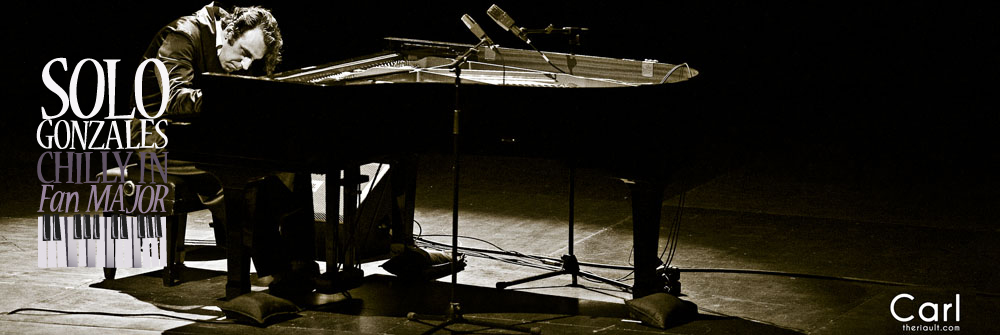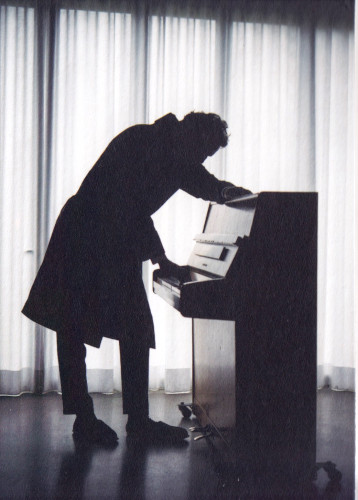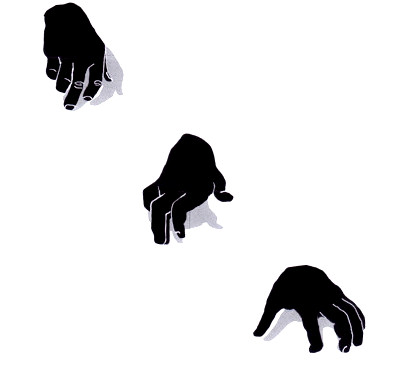 Being futuristic these days means being futuristic on your own terms
Being futuristic these days means being futuristic on your own terms
It appears that Gonzales took his own “Entertainist” lyrics to heart; Solo Piano III represents a gorgeous evolution of solo piano music – a way forward that attracts new fans without alienating current ones. In our eyes (or ears), Solo Piano III is the future; it leads the way into a world filled with musical craftsmanship and beautiful harmonies, where there is time to gaze into the distance and contemplate life, to love, cry, and (of course) have a good laugh.
Gonzales appears to pay tribute to not only past masters (Ravel, Debussy, Satie), but also his own oeuvre, finely balancing a desire to move forward and yet still retain the characteristics that make even a few seconds of solo piano instantly recognizable as Gonzales. A wide range of musical styles: rap, orchestral, dance, solo piano, prankster rap, are all part of Gonzales’ appeal, yet his audience has no idea what he’s going to release next. This change is also happening within his Solo Piano series; each album representing an evolution of Gonzales’ skill and reflection of his cumulative experiences. The original Solo Piano delivered accessible pop hits played on solo piano – Dot, Gogol, and many others could have been transformed and released as dance floor bangers. Solo Piano II transitioned from pop to embrace raw emotions (Kenaston), challenges (White Keys), homage (Papa Gavotte), and timbre techniques (Othello). Solo Piano III continues this evolution, but it’s far more than another installment in the Solo Piano series – to us, Solo Piano III represents a shift in style – moving away from past eras, and into an exploration of the future of music, where pop and Jazz sentiments are combined with harmonic exploration and cyclical, morphing rhythms that shift from one state to another over the course of a few ethereal minutes. Solo Piano III retains the DNA of its predecessors, and yet is a different and unique organism – an accessible evolution of solo piano music, which is a key differentiator when compared to experimental piano music. While the latter is difficult to listen to all but a select few, Gonzales’ compositions inject incremental steps of modernity and brevity (the longest track is 3:46) to maximum effect.
Gonzales seems to seek out information from collaborations, inspiration, practice, and new techniques, and directly or tangentially distills the experience into emotional compositions. A lifetime of experience concentrated in 15 short vignettes – each with its own personality. Gonzales gives his “creations” the ability to survive and thrive on their own accord; some (such as Dot and Knight Moves) grow up, move out of Gonzales’ basement and become fan favourites. The best teachers are also students, and from “The Secrets of Solo Piano III”, it appears that Gonzales continues to devise challenges to overcome at the piano, which is a brilliant strategy, since we become the most creative when under constraints. Which Solo Piano III compositions thrive and take on a life of their own is yet to be seen, but each one is unique and has every opportunity to join the performance ‘gang’, so to speak.
Obviously, examining the songs themselves is a critical part of an album review, yet often overlooked are the associated details that create a memorable experience: art, packaging, recording, and sequencing, consciously or subconsciously combine to enhance the listening experience and reinforce the unique nature of Gonzales’ music.
Cover Art
Long-time Gonzales artist Nina Rhode provided the lovely cover art for Solo Piano I and II, and evolves the smoky shadow of the original Solo Piano, to the solitary silhouette of Solo Piano II, to the disembodied hands of Solo Piano III; the evolution of the art tells a story. The art on the CD itself is particularly interesting – three hands locked onto each other’s forearms, almost the opposite of the Isle of Man Flag, which features three legs and feet arranged in a triangular form. The Isle of Man symbol is meant to convey that no matter how the figure is thrown, it lands on its feet and keeps on running, while Gonzales’ CD art seems to imply that the grip is unbreakable – no particular arm can escape without the others letting go.
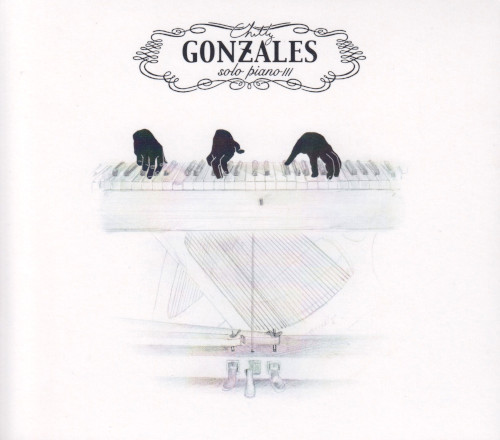 On the Solo Piano III cover, we see the sourdine pedal locked down tight and imagine the care required to straddle the line between soft and loud (hence the sourdine surgeon Carsten Schulz credited on the back of the album). Our view of the piano is that of the performer. We are seated directly in front of the instrument, which sits with its covers removed and mechanism exposed, much like a magician showing the audience their empty hat – “No tricks here – only pure magic!” This performer perspective adds to the intimacy of the music as there’s no seated shadowy figure operating the “controls”. We have the best (and only) seat in the house – a solo performance specifically made for us to combine Gonzales’ music with our experiences to create a truly unique and personal album.
On the Solo Piano III cover, we see the sourdine pedal locked down tight and imagine the care required to straddle the line between soft and loud (hence the sourdine surgeon Carsten Schulz credited on the back of the album). Our view of the piano is that of the performer. We are seated directly in front of the instrument, which sits with its covers removed and mechanism exposed, much like a magician showing the audience their empty hat – “No tricks here – only pure magic!” This performer perspective adds to the intimacy of the music as there’s no seated shadowy figure operating the “controls”. We have the best (and only) seat in the house – a solo performance specifically made for us to combine Gonzales’ music with our experiences to create a truly unique and personal album.
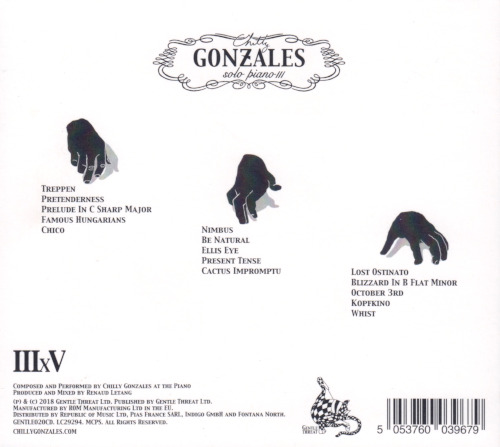 The silhouette from Solo Piano II has now been reduced to three disembodied hands, each caught mid-note within a frame of photo. On the surface, three would allude to the third solo piano album, or possibly that Gonzales’ deft playing makes it sound like there are three hands involved. The third hand could also be akin to our mind’s eye, or third eye, which is often described as our imagination or the images we see in our own head. Gonzales’ two handed playing is supplemented by the listener’s “virtual” hand, which is key to making the songs resonate and be viewed differently with each listener. The hands are reaching out from within the piano and playing from the “wrong” side, which adds to the mysticism in the sense that the music comes from “the other side” of the listener/performer barrier. There are no other visual cues provided – no walls or floor, and even the edges of the piano aren’t drawn, which is similar to how our eyes and brain can only see detail within a narrow spot. The rest our vision picks up peripheral light and movement, but we have to move our eyes or head to see what it actually is. Here, we are focused on the hands that move hypnotically, drawing us in closer to see what those hands are connected to – to find out the “trick” only to realize that knowing the trick breaks the illusion, and deep down, we don’t want to know. We willingly suspend disbelief for a few moments; to put down our connected devices and let our mind wander. The piano is drawn in very light lines, since the physical mechanism that produces the music isn’t as important as the message the music conveys.
The silhouette from Solo Piano II has now been reduced to three disembodied hands, each caught mid-note within a frame of photo. On the surface, three would allude to the third solo piano album, or possibly that Gonzales’ deft playing makes it sound like there are three hands involved. The third hand could also be akin to our mind’s eye, or third eye, which is often described as our imagination or the images we see in our own head. Gonzales’ two handed playing is supplemented by the listener’s “virtual” hand, which is key to making the songs resonate and be viewed differently with each listener. The hands are reaching out from within the piano and playing from the “wrong” side, which adds to the mysticism in the sense that the music comes from “the other side” of the listener/performer barrier. There are no other visual cues provided – no walls or floor, and even the edges of the piano aren’t drawn, which is similar to how our eyes and brain can only see detail within a narrow spot. The rest our vision picks up peripheral light and movement, but we have to move our eyes or head to see what it actually is. Here, we are focused on the hands that move hypnotically, drawing us in closer to see what those hands are connected to – to find out the “trick” only to realize that knowing the trick breaks the illusion, and deep down, we don’t want to know. We willingly suspend disbelief for a few moments; to put down our connected devices and let our mind wander. The piano is drawn in very light lines, since the physical mechanism that produces the music isn’t as important as the message the music conveys.
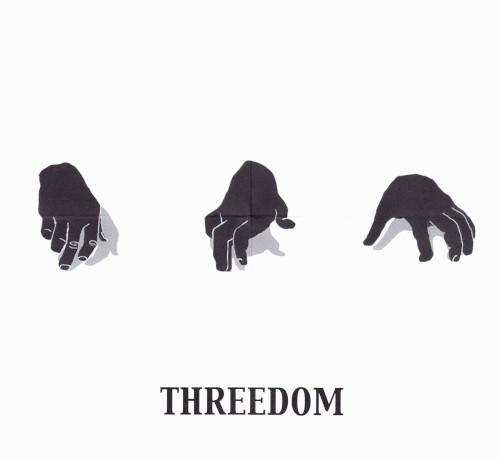 There are also a few distinct words and symbols on the covers of the album: “IIIxV”, “Pentagonz”, “Threedom”. Starting with the latter, Gonzales formed a “sleaze funk” band called “Feedom” (possibly a clever play on the price of freedom) with Peaches in the late 1990s, and included a song called “Feedom Freestyle” on The Entertainist. The ‘-dom’ suffix can be added to make a domain out of many words, for example, “Gonzdom” would be all things Gonzales, ‘feedom’ would be all things with a fee, and “threedom” would be all things relating to threes. “Pentagonz” likely alludes to the Roman numeral notation for major triads (V or five), or possibly the pentatonic scale, which uses 5 notes per octave and is commonly found in Jazz, blues, and Hungarian folk music. Considering that “III” represents a minor triad, the text “IIIxV” on the back of the album cover may imply, “minor vs. major”, which is an evolution of Gonzales’ previous “major to minor” stance. This may be a musical hint as to the sequencing of songs, or even a shift in attitude – a subaudible subtext duel between major chords and minor keys, which retells the oldest story – the struggle to survive (we’ll examine this concept in more detail when we review the songs).
There are also a few distinct words and symbols on the covers of the album: “IIIxV”, “Pentagonz”, “Threedom”. Starting with the latter, Gonzales formed a “sleaze funk” band called “Feedom” (possibly a clever play on the price of freedom) with Peaches in the late 1990s, and included a song called “Feedom Freestyle” on The Entertainist. The ‘-dom’ suffix can be added to make a domain out of many words, for example, “Gonzdom” would be all things Gonzales, ‘feedom’ would be all things with a fee, and “threedom” would be all things relating to threes. “Pentagonz” likely alludes to the Roman numeral notation for major triads (V or five), or possibly the pentatonic scale, which uses 5 notes per octave and is commonly found in Jazz, blues, and Hungarian folk music. Considering that “III” represents a minor triad, the text “IIIxV” on the back of the album cover may imply, “minor vs. major”, which is an evolution of Gonzales’ previous “major to minor” stance. This may be a musical hint as to the sequencing of songs, or even a shift in attitude – a subaudible subtext duel between major chords and minor keys, which retells the oldest story – the struggle to survive (we’ll examine this concept in more detail when we review the songs).
Packaging
 There’s a certain quality that playing Solo Piano III on an LP brings out; the surface noise and occasional pop enhance rather than detract from the music, and Gonzales made Solo Piano III a double LP, which greatly improves sonic quality. Each of the two albums has a different feature on the sleeve. On one LP, a selection of five Herr von Eden bathrobes are hanging, possibly as a nod to the various moods that can be expressed by the songs. On the other sleeve, the three hands reappear without the piano mechanism – here almost like three frames of a movie caught in time, which is reminiscent of the brilliant “Trick of the Light” from Gonzales’ “Room 29″ collaboration. Movies are a trick of the light – capturing frames and playing them back until your brain cannot discern the difference. Digital audio sampling is somewhat analogous in that sound is converted to a digital signal in discrete steps and then replayed back so quickly that we perceive the sound as continuous. There is, however, sheet music, which is as close as we have to capturing what Gonzales was communicating, and we’re fortunate that Gonzales strives to publish high-quality musical notebooks for practically all his solo piano music. We don’t have a copy of the Solo Piano III notebook yet, but we’ll definitely publish a future review.
There’s a certain quality that playing Solo Piano III on an LP brings out; the surface noise and occasional pop enhance rather than detract from the music, and Gonzales made Solo Piano III a double LP, which greatly improves sonic quality. Each of the two albums has a different feature on the sleeve. On one LP, a selection of five Herr von Eden bathrobes are hanging, possibly as a nod to the various moods that can be expressed by the songs. On the other sleeve, the three hands reappear without the piano mechanism – here almost like three frames of a movie caught in time, which is reminiscent of the brilliant “Trick of the Light” from Gonzales’ “Room 29″ collaboration. Movies are a trick of the light – capturing frames and playing them back until your brain cannot discern the difference. Digital audio sampling is somewhat analogous in that sound is converted to a digital signal in discrete steps and then replayed back so quickly that we perceive the sound as continuous. There is, however, sheet music, which is as close as we have to capturing what Gonzales was communicating, and we’re fortunate that Gonzales strives to publish high-quality musical notebooks for practically all his solo piano music. We don’t have a copy of the Solo Piano III notebook yet, but we’ll definitely publish a future review.
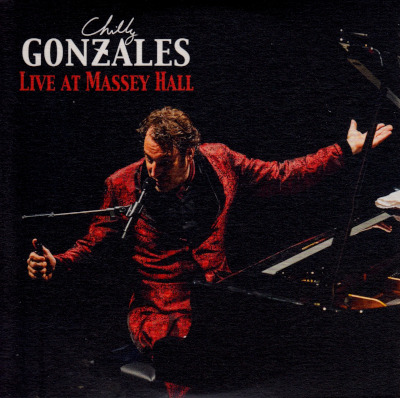 The deluxe CD comes with a wonderful “Live at Massey Hall” performance, which is as close to a live Gonzales performance as one can achieve (although nothing beats experiencing Gonzales in concert). Surprisingly, the Solo Piano III CD case does include a silhouette of Gonzales standing at the piano on the inside cover (taken by longtime Gonzales photographer Alexandre Isard), more akin to someone walking up and playing a couple of notes on a piano, versus sitting down to a composition. The CD also comes with a small pull-out poster contains the five-bathrobe picture, and is a great small surprise which makes purchasing the physical disc much more satisfying than the digital download.
The deluxe CD comes with a wonderful “Live at Massey Hall” performance, which is as close to a live Gonzales performance as one can achieve (although nothing beats experiencing Gonzales in concert). Surprisingly, the Solo Piano III CD case does include a silhouette of Gonzales standing at the piano on the inside cover (taken by longtime Gonzales photographer Alexandre Isard), more akin to someone walking up and playing a couple of notes on a piano, versus sitting down to a composition. The CD also comes with a small pull-out poster contains the five-bathrobe picture, and is a great small surprise which makes purchasing the physical disc much more satisfying than the digital download.
The Recording
The first sonic quality heard on listening to Solo Piano III is the lowered noise floor; the recording is beautifully clean and clear. Uprights are unforgiving, since there’s no grand piano belly that separates performer from instrument (even though Oscar Peterson, Keith Jarrett, and Glenn Gould’s humming somewhat breaks down the barrier), there’s nowhere to sonically hide the sound of the performer, keyboard action, pedal noise – it’s all captured and becomes part of the ambience. Since Solo Piano II, Gonzales uses his own Bechstein upright for recording, we can only assume that the piano made the journey to the recording studio for Solo Piano III. Mastering the recording was changed from Mandy Parnell at Black Saloon Studios to Benjamin Joubert (who mastered the original Solo Piano), which may explain some of the sonic differences, plus a change in studio from Studio Pigalle in Paris to Maarwegstudio 3 in Cologne, all of which seems to have resulted in a more precise sound.
Intimate Sounds
Gonzales has said that with the proliferation of personal music players and digital music, the listening experience has changed from social to much more personal and intimate. After listening to Solo Piano III on LP through speakers, then switching to the CD and headphones, it appears that Gonzales and his team have created an album that is geared towards an enhanced headphone listening experience. It’s difficult to describe, but the album sounds even better through a good set of headphones, which may be Gonzales’ nod to moving with his audience. Historically, composers strive to arrange music that sounded great in the orchestra hall, then with advancements in technology and society, chamber music within people’s living rooms, which gave way eventually to records and shared listening experiences, and now portable devices to listen practically anywhere. It’s obviously an evolution that Gonzales has not only embraced, but experienced on albums ranging from The Unspeakable Chilly Gonzales, to Chambers, and the Solo Piano series. The stereo separation is distinct and satisfying, and there is also the addition of subtle panning on certain tracks, which adds to the experience.
Sequencing
There’s definitely an artistic quality to selecting the order in which songs appear on an album. At the club, DJs will carefully select songs to keep people dancing, occasionally interrupted by a slow number to allow people to relax before diving into another sequence of thumping dance numbers. On an album, it’s important to curate a sequence that is true to the intent of the album – the sequence tells a story, and it’s an unfortunate fact of technology that the sequence can be “shuffled” or individual songs can be purchased, which, to some degree, “breaks” the overall album flow. It may even be the case that a performer is trying to tell a story not only through an individual song, but through an album, or even a series of albums. It’s been said that Gonzales’ longtime friend Feist has the ability to listen to songs and select an optimal order – some people just have “the gift”. Gonzales indicates on “The Secrets of Solo Piano III” that there are commonalities between the sequencing of all three Solo Piano albums, which helps to tell a larger story at a level above the songs themselves – a musical journey.
The Songs
Gonzales’ musical journey takes us through a wide gamut of emotions – from humour to melancholy, joy to frenzied emotions; each song is a unique multifaceted gemstone that reveals a beautiful pattern when examined from different angles. In upcoming posts, we’ll have an in-depth review of each composition, which will hopefully expand your own appreciation for the music and Gonzales’ talent. In the last post, we’ll have a look at overarching themes and messages and feature a Solo Piano III concert review from Gonzales’ return to his hometown of Montreal. To set us off, we challenged ourselves to come up with a very short synopsis of each song, and an in-depth look at the very first song – Treppen.
One-Line Thoughts
Treppen: Gonzales leads the way though twisty passages
Pretenderness: Floating down from a relationship high
Prelude In C Sharp Major: Temporal phrase transitions to great effect
Famous Hungarians: Introducing the forerunner of Ragtime, Jazz, Rock, and Pop
Chico: Our long-lost Dot relative pays us an all-too-brief visit
Nimbus: Little fluffy clouds part to reveal a divine halo
Be Natural: It’s ok to sometimes leave things unresolved
Ellis Eye: A melody that sings like everyone’s listening
Present Tense: Bernard Hermann is getting nervous
Cactus Impromptu: Arizona sunrises sure are beautiful
Lost Ostinato: Subconsciously, we’re attracted to the Mesmerizing bassline
Blizzard In B Flat Minor: Sometimes, you have to dig your way out
October 3rd: We love it when things come together
Kopfkino: Satie dreams of funk
Whist: A few gentle thoughts before you leave
Treppen
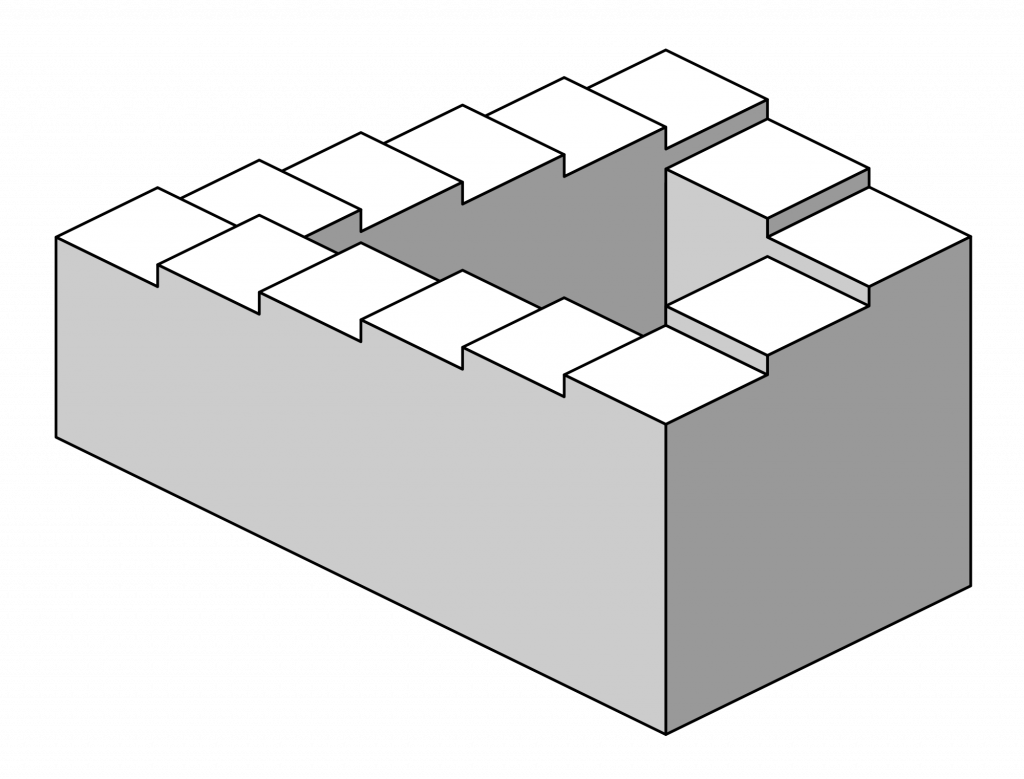 In earlier Gonzales songs, he seems to play with “elevation” as metaphor for ability, beliefs, and even social status. “Higher than You”, “Political Platform Shoes”, “Bottom of the Pops”, and even the endless staircases of Solo Piano II’s “Escher” all use varying heights to impart a message. Here, Treppen translates from German to stairs or “staircase”, but we’re not entirely sure where this staircase leads to and whether we’re heading up or down. We’re entering Gonzales’ musical home, and although there are plenty of interesting rooms, he has a new addition to show us and leads the way through a twisty path. As Gonzales points out on “The Making of Solo Piano III”, scales are musical stairs that can head up or down (and you can skip ahead and take two of three at a time). The musical stairs in this case impart the feeling that we’re off exploring – maybe even becoming a bit lost, and by the end of the song, we definitely have the feeling that we haven’t returned back to where we started. As 1:30, Treppen is the shortest track on Solo Piano III, but is a pivotal first piece – one that serves as an introduction to the listener, slowly and gently opening up our mind to accept the messages that follow. Gonzales has led the way to the new addition, but he’s nowhere to be seen, and we’re face-to-face with his bouncer. The only way inside is to allow our minds to take a musical journey – one that will challenge our emotions and make its way into our soul.
In earlier Gonzales songs, he seems to play with “elevation” as metaphor for ability, beliefs, and even social status. “Higher than You”, “Political Platform Shoes”, “Bottom of the Pops”, and even the endless staircases of Solo Piano II’s “Escher” all use varying heights to impart a message. Here, Treppen translates from German to stairs or “staircase”, but we’re not entirely sure where this staircase leads to and whether we’re heading up or down. We’re entering Gonzales’ musical home, and although there are plenty of interesting rooms, he has a new addition to show us and leads the way through a twisty path. As Gonzales points out on “The Making of Solo Piano III”, scales are musical stairs that can head up or down (and you can skip ahead and take two of three at a time). The musical stairs in this case impart the feeling that we’re off exploring – maybe even becoming a bit lost, and by the end of the song, we definitely have the feeling that we haven’t returned back to where we started. As 1:30, Treppen is the shortest track on Solo Piano III, but is a pivotal first piece – one that serves as an introduction to the listener, slowly and gently opening up our mind to accept the messages that follow. Gonzales has led the way to the new addition, but he’s nowhere to be seen, and we’re face-to-face with his bouncer. The only way inside is to allow our minds to take a musical journey – one that will challenge our emotions and make its way into our soul.
Final Thoughts (until the next installment)
As always, Gonzales’ Solo Piano albums contain surprises and include the unmistakable Gonzales style. Like its predecessors, we keep discovering new angles and hidden dimensions with each Solo Piano III listen, usually dependent on our listening mood and environment. The famous 1950 Japanese movie Rashomon explores the same key event from four different witness perspectives. Each account of the event differs, and yet they all make sense and describe the event though the witnesses’ unique viewpoint. Solo Piano III feel very “Rashomon” – each listener will have a unique perspective of the songs, and each differs based on personal experiences. There’s no right or wrong – just a highly enjoyable listening experience.
While waiting for the next post, please feel free to leave comments and thoughts. Gonzales is on-tour (we highly recommend catching a show), and Solo Piano III is available everywhere, with special signed editions available at Rough Trade.
